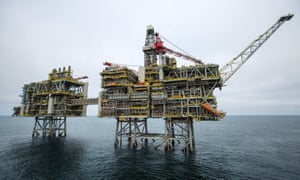IEA says hundreds of billions of dollars must go into new fields to meet demand from markets such as India and China

Production at BP’s Clair Ridge oilfield, 75km west of the Shetlands, will start next year.
Photograph: BP
The world will be hit by sharp increase in oil prices in the next decade without a major investment in new fields, one of the world’s leading energy authorities has warned.
The International Energy Agency said after a two year-slump the industry was making a weak recovery, which would coincide with India and China continuing to drive up oil demand. The result would be a tight market and surge in oil prices towards 2022 without further action, the IEA concluded in a report.
Oil majors such as BP and Shell have been cautiously upbeat about the number of final investment decisions they will take on new projects this year, buoyed by an oil price that has settled at about $55 (£45) a barrel after the biggest oil-producing countries agreed to curb production last December.
Last week Shell made a final investment decision to proceed on a Gulf of Mexico deepwater project, the first such approval it had made in more than 18 months.
But the IEA called the industry’s recovery modest and said at current rates it would not be enough to catch up on a backlog of lost investment in the last two years, when it fell by a quarter annually because of low oil prices.
“In 2015 and 2016 investment in the upstream oil industry has been at record lows. It’s not recovering significantly in 2017,” said Neil Atkinson, one of the report’s authors. He said hundreds of billions of dollars of extra investment was needed to avoid a crunch.
The Paris-based organisation said it was surprised oil markets were so sanguine about the risk of too few new projects being confirmed.
Fatih Birol, the IEA’s executive director, said: “This is no time for complacency. We don’t see a peak in oil demand any time soon. And unless investments globally rebound sharply, a new period of price volatility looms on the horizon.”
The US would take the number one slot worldwide for oil supply growth in the next five years, the agency predicted. That increase would be driven not by Donald Trump’s pro-oil energy policy – which the IEA expected would take time to have an impact – but from continuing success for low-cost, shale oil drillers.
The next two fastest-growing oil suppliers are expected to be Canada and Brazil. Inside the Opec, the bulk of new supplies is anticipated to come from Iraq, the UAE and Iran, though that could be affected by the wild card of further sanctions on the latter.
The agency said although there was some uncertainty over supplies, the picture on demand was clearer. With the IMF expecting economic growth of 3.7% a year, the IEA said oil demand would grow 1.2% up to 2022, with China and India accounting for half of new demand alone. Demand is expected to pass the symbolic milestone of 100 million barrels per day in 2019, up from 96.6mb/d last year.
The developing world’s hunger for oil was one reason the situation today was different to the last time oil exploration investment collapsed so severely, in the early 1980s, the IEA said.
Atkinson, the IEA’s head of oil industry and markets division, said: “Global oil demand [in the early 1980s] fell three years in a row. There was lot of spare capacity around, so companies cut back in investment. Today we are in situation where oil demand is expected to continue to grow.”
The impact of electric cars, which some analysts have predicted will seriously erode future growth in oil demand, is seen as negligible by the IEA. “While the much-discussed growth in the electric vehicles fleet is a very important longer term issue for oil demand, by 2022 we estimate that only limited volumes of global transport fuel demand will be lost to electric vehicles from conventional fuels,” the report said.
In the UK, the expectation is that the oil production growth seen in the past two years will go into decline, before picking up next year as large projects such as BP’s Clair Ridge and Quad 204 developments in the North Sea start up. Those two alone will add about a 10th to the UK’s annual oil production when fully operational.










